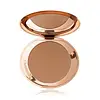What's inside
What's inside
 Key Ingredients
Key Ingredients

 Benefits
Benefits

 Concerns
Concerns

 Ingredients Side-by-side
Ingredients Side-by-side

C12-15 Alkyl Ethylhexanoate
EmollientZinc Stearate
Cosmetic ColorantMethyl Methacrylate/Glycol Dimethacrylate Crosspolymer
Alumina
AbrasiveLauroyl Lysine
Skin ConditioningPentaerythrityl Tetraethylhexanoate
EmollientCaprylyl Glycol
EmollientWater
Skin ConditioningBisabolol
MaskingPanthenyl Triacetate
Hexylene Glycol
EmulsifyingTriethoxycaprylylsilane
Silica
AbrasiveBHT
AntioxidantPotassium Sorbate
PreservativePhenoxyethanol
PreservativeFarnesyl Acetate
PerfumingFarnesol
PerfumingMica
Cosmetic ColorantCI 77891
Cosmetic ColorantCI 77491
Cosmetic ColorantCI 77492
Cosmetic ColorantCI 77499
Cosmetic ColorantCI 77007
Cosmetic ColorantCI 75470
Cosmetic ColorantCI 19140
Cosmetic ColorantC12-15 Alkyl Ethylhexanoate, Zinc Stearate, Methyl Methacrylate/Glycol Dimethacrylate Crosspolymer, Alumina, Lauroyl Lysine, Pentaerythrityl Tetraethylhexanoate, Caprylyl Glycol, Water, Bisabolol, Panthenyl Triacetate, Hexylene Glycol, Triethoxycaprylylsilane, Silica, BHT, Potassium Sorbate, Phenoxyethanol, Farnesyl Acetate, Farnesol, Mica, CI 77891, CI 77491, CI 77492, CI 77499, CI 77007, CI 75470, CI 19140
Ingredients Explained
These ingredients are found in both products.
Ingredients higher up in an ingredient list are typically present in a larger amount.
This ingredient comes from a fatty acid (lauric acid) and amino acid (lysine). It is used to add a silky feel to cosmetics.
According to a manufacturer, its fatty acid base leaves a silky feeling on the skin. It also has emollient properties because of this. Emollients help soften skin by preventing water from evaporating.
Lauroyl lysine is barely soluble in water.
Learn more about Lauroyl LysineMica is a naturally occurring mineral used to add shimmer and color in cosmetics. It can also help improve the texture of a product or give it an opaque, white/silver color.
Serecite is the name for very fine but ragged grains of mica.
This ingredient is often coated with metal oxides like titanium dioxide. Trace amounts of heavy metals may be found in mica, but these metals are not harmful in our personal products.
Mica has been used since prehistoric times throughout the world. Ancient Egyptian, Indian, Greek, Roman, Aztec, and Chinese civilizations have used mica.
Learn more about MicaPotassium Sorbate is a preservative used to prevent yeast and mold in products. It is commonly found in both cosmetic and food products.
This ingredient comes from potassium salt derived from sorbic acid. Sorbic acid is a natural antibiotic and effective against fungus.
Both potassium sorbate and sorbic acid can be found in baked goods, cheeses, dried meats, dried fruit, ice cream, pickles, wine, yogurt, and more.
You'll often find this ingredient used with other preservatives.
Learn more about Potassium SorbateSilica, also known as silicon dioxide, is a naturally occurring mineral. It is used as a fine, spherical, and porous powder in cosmetics.
Though it has exfoliant properties, the function of silica varies depending on the product.
The unique structure of silica enhances the spreadability and adds smoothness, making it a great texture enhancer.
It is also used as an active carrier, emulsifier, and mattifier due to its ability to absorb excess oil.
In some products, tiny microneedles called spicules are made from silica or hydrolyzed sponge. When you rub them in, they lightly polish away dead skin layers and enhance the penetration of active ingredients.
Learn more about SilicaZinc Stearate is the metal salt of stearic acid. It is a white solid used to bind, thicken, and lubricate products.
This ingredient is common in powder makeup, where it helps keep the powder together.
Zinc Stearate is hydrophobic and repels water.
This ingredient can be sourced from non-animal or animal sources. It is best to reach out to the brand to see where they source this ingredient from.
Learn more about Zinc Stearate